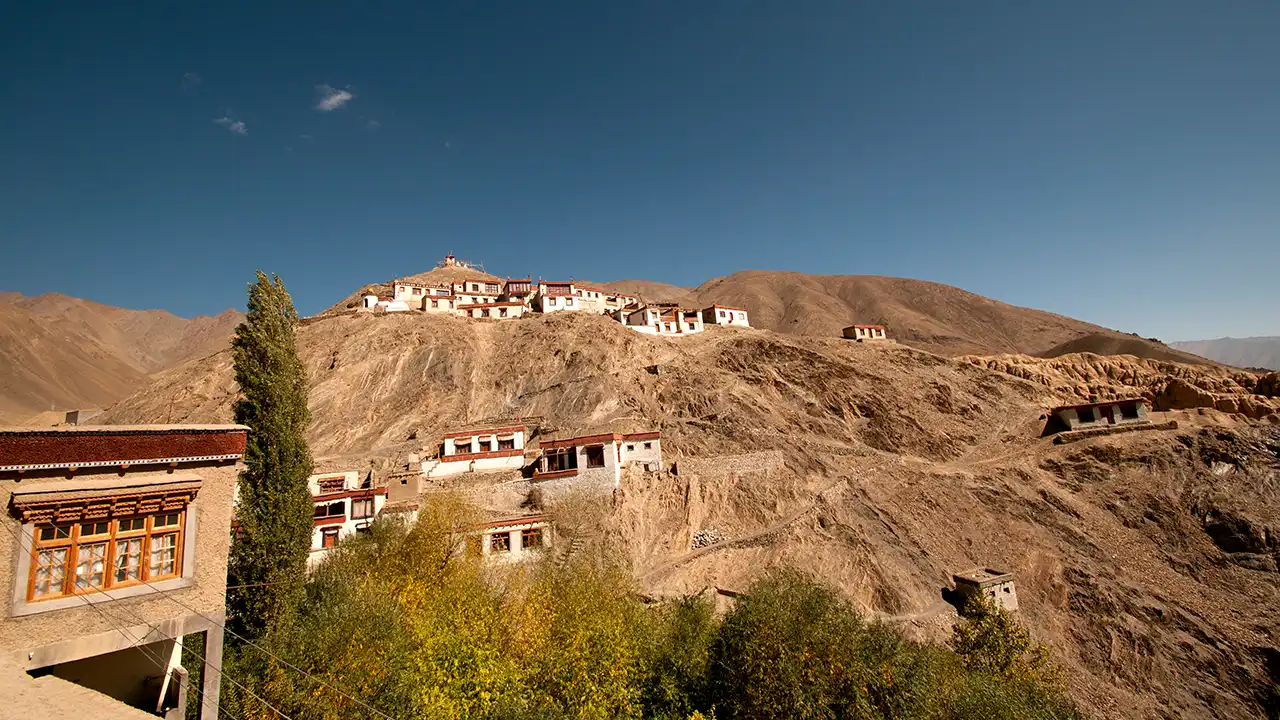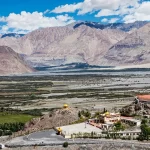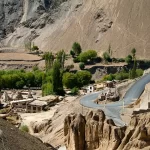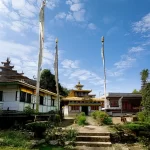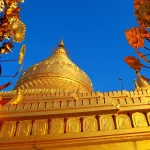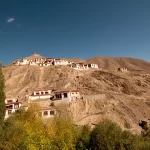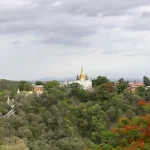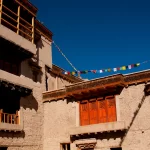Thiksey Monastery, proudly standing on top of a hill in the Indus Valley, is Ladakh’s largest and most prominent Buddhist monastery, colloquially referred to as the “Mini Potala” due to its striking similarity with the Potala Palace of Lhasa, Tibet. Situated 19 km east of Leh in Thiksey village, this 15th-century gompa, which is part of the Gelug sect of Tibetan Buddhism, is at an altitude of 3,600 meters, providing stunning vistas of snow-covered mountains and the green Indus floodplain. Famous for its architectural splendour, religious importance, and colourful festivals, Thiksey Monastery is a must-see for Buddhist pilgrims and tourists visiting Ladakh. This 1000-word article explores its history, architecture, cultural significance, festivals, and travel advice, SEO-optimized with high keyword usage for “Thiksey Monastery,” “Ladakh,” and “Buddhist pilgrimage.”
History and Origins of Thiksey Monastery
Thiksey Monastery, founded around the mid-15th century, owes its origins to the Gelugpa sect’s expansion during the tenure of Jangsem Sherab Zangpo, a student of Tsongkhapa, the founder of Gelug. In 1433, Zangpo established a minor monastery, Lhakhang Serpo (“Yellow Temple”), in Stagmo, north of the Indus. His disciple Palden Zangpo later constructed the bigger Thiksey Monastery, following a miraculous indication: two crows took away a torma (offer cake) in a ritual to a hill, putting it exactly in place, indicating the holy spot. This tradition is named Thiksey, which means “perfect order.”
The monastery increased its stature, rivalled only by Hemis Monastery in Ladakh, presiding over a further ten other gompas, such as Diskit, Spituk, and Likir. By the 18th century, it governed 1,327 acres and 25 villages. The historical connection to the Namgyal dynasty and the status as a monastic seat for the royal princes, such as Jigsmet Namgyal, solidified its influence. The 14th Dalai Lama’s 1970 visit, marked by the Maitreya Temple, and his scheduled 2025 visit underscore its international spiritual importance.
Architectural Splendor of Thiksey Monastery
Thiksey Monastery’s 12-story complex, which cascades down a hill, is an optical wonder, coated in red, white, and ochre colours, and integrating beautifully into Ladakh’s tough landscape. Its hierarchical plan locates the holiest structures, such as the main prayer hall (Dukhang) and the residence of the chief lama (potang), on top, and monks’ living quarters at the bottom. A huge chagri (perimeter wall) and a gateway lined with white chortens (stupas) and mani walls precede the central courtyard.
The Maitreya Temple, which contains a 15-meter-tall statue of Maitreya Buddha—the tallest in Ladakh, spanning two stories—is the focal point of the monastery. Erected in 1970 to commemorate the Dalai Lama’s visit, the gold-coated clay statue, made by local craftsmen, has Buddhist canonical literature inside. The Tara Temple, containing 21 depictions of Goddess Tara, and the Lamokhang Temple, where Kangyur and Stangyur scriptures are kept (women are not allowed in) are other notable features. The main assembly hall contains murals of the Tibetan calendar, and thangkas, stupas, and swords decorate the ten temples.
The nunnery at Nyerma, donated by Thiksey Monastery, accommodates 26 nuns, testifying to its belief in gender equality in Buddhist monasticism. The recent refurbishment, featuring a new kitchen and dining hall, has caused controversy over the use of modern materials such as granite, which interfere with the traditional look. Nevertheless, Thiksey architecture is a witness to Ladakh’s Buddhist heritage.
Cultural and Spiritual Importance
Thiksey Monastery is a living spiritual hub, home to 120 monks and a nunnery, fostering Gelugpa teachings and Buddhist philosophy. Its morning prayers at 7 AM, with synchronized sutra chanting, draw worshippers and tourists seeking tranquility. The monastery’s museum preserves ancient artifacts, while its school trains young lamas, ensuring the continuity of Buddhist traditions.
The nunnery’s development, backed by the 1995 Sakyadhita Conference and the Ladakh Nuns Association, represents a transformation from nuns past marginalization to empowerment, with Thiksey Rinpoche leading the way. Nuns today call themselves “Chomos” (female religious practitioners), claiming their religious role. Thiksey’s influence also permeates Ladakhi culture, with its festivals and trade fairs building community ties.
Festivals at Thiksey Monastery
The Gustor Festival, which annually takes place on the 17th to 19th of the ninth month of Tibet (October–November), is Thiksey Monastery’s feature event. Marked by pious Cham dances by masked lamas, laced with the sound of cymbals, horns, and conch shells, the celebration commemorates virtue over evil culminating in burning an effigy. A base trade fair draws villagers from around Ladakh for exchanging crafts and socializing to colour the festivity. Visiting Gustor provides a profound insight into Ladakhi culture and Buddhist ceremonies, hence its peak season as a site for Buddhist pilgrimage.
Why Visit Thiksey Monastery?
Thiksey Monastery blends spiritual calm, architectural splendor, and cultural depth, making it one of Ladakh’s premier attractions. Its sweeping views of the Indus Valley, with Stok, Shey, and Matho monasteries in view, mesmerize tourists. The Maitreya Buddha statue, elaborate murals, and serene atmosphere provide a deep experience for pilgrims and photographers alike. Nearby places such as Shey Palace, Hemis Monastery, and the Rancho School (of 3 Idiots fame) add to the itinerary.
Best Time to Visit Thiksey Monastery
May to September, when Ladakh’s weather is nice and roads are available, is the best time to visit Thiksey Monastery. October–November, to attend the Gustor Festival, is ideal to experience culture. From November to February, the monastery remains closed because of heavy snowfall, so visiting during winter is not easy. Visit in the early morning to see the prayers and escape the crowd.
How to Reach Thiksey Monastery
Thiksey Monastery is conveniently reachable from Leh, 19 km distant, on the Leh-Manali National Highway.
By Road: Take a taxi or rent a bike from Leh for a 25–30-minute ride. JK SRTC buses from Leh bus stand ply every 15 minutes (frequently during festivals).
By Air: Leh’s Kushok Bakula Rimpochee Airport (25 km) is closest, with taxis plying.
By Train: The nearest railway station is Jammu Tawi (700 km), and then a long road trip.
Non-residents might need an Inner Line Permit (ILP), which can be purchased online or in Leh. A fee of INR 30–40 is charged for entry to the monastery.
Travel Tips for Thiksey Monastery
Respect Customs: Be quiet, dress conservatively, and have phones on silent mode. Photography is permitted (no flash); video needs permission.
- Altitude Awareness: Acclimatize to 3,600 meters to prevent altitude sickness. Rest and hydrate.
- Facilities: Restaurant and souvenir shop exist, but limited food choices. Plan meals.
- Accommodation: Stay at the monastery for nominal fees or in Leh’s hotels. Book early during festivals.
- Combine Visits: Combine with Hemis, Shey, or Pangong Lake for a day trip.
Thiksey Monastery in Ladakh is a cultural and spiritual treasure, where ancient Buddhist heritage is beautifully mixed with breathtaking Himalayan landscapes. Its 600-year history, imposing Maitreya Buddha, and colourful Gustor Festival make it a foundation of Buddhist pilgrimage and a gem of Ladakh tourism. If you are looking for peace, history, or adventure, Thiksey Monastery guarantees an experience that will not be forgotten. Visit this “Mini Potala” and become one with the core of Ladakh’s Buddhist heritage.

